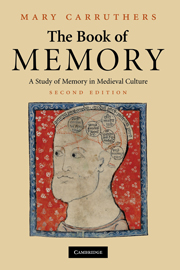Book contents
- Frontmatter
- Contents
- List of Illustrations
- Preface to the second edition
- List of Abbreviations
- Introduction
- CHAPTER 1 Models for the memory
- CHAPTER 2 Descriptions of the neuropsychology of memory
- CHAPTER 3 Elementary memory design
- CHAPTER 4 The arts of memory
- CHAPTER 5 Memory and the ethics of reading
- CHAPTER 6 Memory and authority
- CHAPTER 7 Memory and the book
- Appendix A
- Appendix B
- Appendix C
- Notes
- Bibliography
- Index of manuscripts
- General Index
CHAPTER 3 - Elementary memory design
Published online by Cambridge University Press: 05 January 2014
- Frontmatter
- Contents
- List of Illustrations
- Preface to the second edition
- List of Abbreviations
- Introduction
- CHAPTER 1 Models for the memory
- CHAPTER 2 Descriptions of the neuropsychology of memory
- CHAPTER 3 Elementary memory design
- CHAPTER 4 The arts of memory
- CHAPTER 5 Memory and the ethics of reading
- CHAPTER 6 Memory and authority
- CHAPTER 7 Memory and the book
- Appendix A
- Appendix B
- Appendix C
- Notes
- Bibliography
- Index of manuscripts
- General Index
Summary
THE NUMERICAL GRID
The architectural mnemonic was not the only, or even the most popular, system known in the Middle Ages for training the memory. In her 1936 study of the subject, Helga Hajdu mentions various alternative systems, including an elaborate digital method of computation and communication that also served mnemonic purposes, discussed in the treatise De loquela digitorum ascribed to Bede; various mnemonic verses that serve both scholars and laity, such as the university students’ mnemonic for remembering the various types of syllogism (“Barbara Celarunt Darii,” etc.) and the execrable rhyming hexameters used by lawyers as a mental index to the various collections of laws; and various counting devices, like the rosary and the abacus, which involve manipulating physical objects in a rigid order as an aide-mémoire in calculation. There are rhyming catalogues of medieval libraries which were intended to be memorized by the monks, and there are Alexandre de Villedieu’s 4,000 rhymed hexameters setting forth the rules of Latin grammar, the Doctrinale. One of the earliest and longest-lived poems in English is the mnemonic for the months of the year: “Thirty days hath September, April, June and November.”
Interesting as these particular items are, however, they are too limited in purpose or too bound to a particular situation, such as the monastery or the law court, to be of much interest in considering how memories were trained by a wide variety of people to make a securely searchable inventory of a variety of texts and other material (what Albertus Magnus lumps together as negotia, a word usually understood as “business,” but in the context of memory-training it translates better as “matters,” “content,” or even “stuff”). Other systems of memory training clearly surpassed that described in the Ad Herennium, in both their longevity and their broad applicability to all spheres of learning. And, unlike the Herennian mnemonic, they were widely disseminated in the Middle Ages (not just the humanist circles in papal Avignon and in Tuscany), and find their way into practical writings on the subject of memory well before the fourteenth century. In this chapter, I will be concerned with two simple schemes used in memory training. They employ the most common of locational heuristics, the order of numbers, and that of the alphabet.
- Type
- Chapter
- Information
- The Book of MemoryA Study of Memory in Medieval Culture, pp. 99 - 152Publisher: Cambridge University PressPrint publication year: 2008



